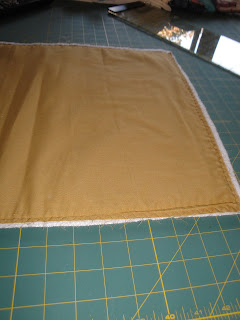Insulated Food Carrier
Part 2
First, set aside your flap pieces that you worked on previously in Part 1.
Next, we will work with the handle sections. I have chosen a coordinating fabric simply because I was using what I had in my fabric stash.
On the handle sections (30"x15" pieces) you will simply do the same thing, by attaching (I did this by using my sewing machine with a walking foot, but you can simply use needle and thread and baste the Insul-Bright to the WRONG SIDE of each handle section of fabric (Add Insul-Bright to both pieces). Following that I simply placed the WRONG SIDES TOGETHER (yes, both pieces of Insul-Bright will be facing and touching each other) and basted them together. When you have completed these steps your handle section will look like the picture above.
Next, you will cut the short ends of the handle section so that you will be able to insert the wooden dowels later. Both ends will be cut to the dimensions shown above. (You can click on the picture for a larger view.)
SET ASIDE YOUR HANDLE SECTION.
Next, we will be making binding strips for both the flap sections and the handle sections of the insulated carrier. I will be using the opposite fabric to make binding strips to unify the contrasting fabrics. First, lay your folded fabric on the table with the fold towards you and the selvages away from you.
If you have a plastic ruler and rotary cutter, the next step is very simple. However, a plastic ruler and rotary cutter is NOT necessary!! I will explain how you can use simple tools to suffice.
If you have the plastic ruler (I like Omnigrid rulers), line up the 2 1/2 inch line along the STRAIGHT edge of the fabric on the left side (line up and cut off the edge of the fabric if it is not straight PRIOR to cutting this strip)
If you do not have the ruler and rotary cutter, simply use a pencil or chalk or some kind of marking tool and use a tape measure and mark over 2 1/2 inches in several spots so you can line up the marks with a yardstick or similar straight edge. Mark along the straight edge with your marking tool (pencil, or ?) and then cut carefully with a pair of scissors along the line you've marked. You will need to make about 5 of these 2 1/2 inch strips.
Next, cut off your selvage edges.
Now, lay one strip in front of you on the table like this. (See above)
Next, lay another strip RIGHT SIDES TOGETHER, as shown above.
Next, you will mark a line from the left upper edge to the right lower edge of the overlapping area. VERY IMPORTANT!!! - THAT YOU FOLLOW THIS CAREFULLY, OR YOUR PIECE WILL NOT RESULT IN A STRAIGHT STRIP.
Cut the seam allowance to approximately 1/4 to 1/2 inch wide. Open out the edges and press the seam allowance open. When you have completed these steps your strip will be connected and look like this below. Continue to do the same steps for all the strips until you have one long strip 2 1/2 inches wide.
Next, you will go to your ironing board, as you can see above, I've done the same thing for my alternate color strips. (Yes, you would be doing 5 more strips like the ones you just completed) As you can see, the completed strip is laying on my ironing board lengthwise. Next, I'm going to fold over the bottom edge and line up the top edges (wrong sides together) and press with my iron.
In summary, you should now have binding strips for both the handle section and the flap section of your insulated food carrier. In Part 3, I will demonstrate how to quilt the handle and flap sections (if you wish), finish the edges, connect the parts, and add the dowels. Stay tuned for Part 3 within the next day or so.
















No comments:
Post a Comment